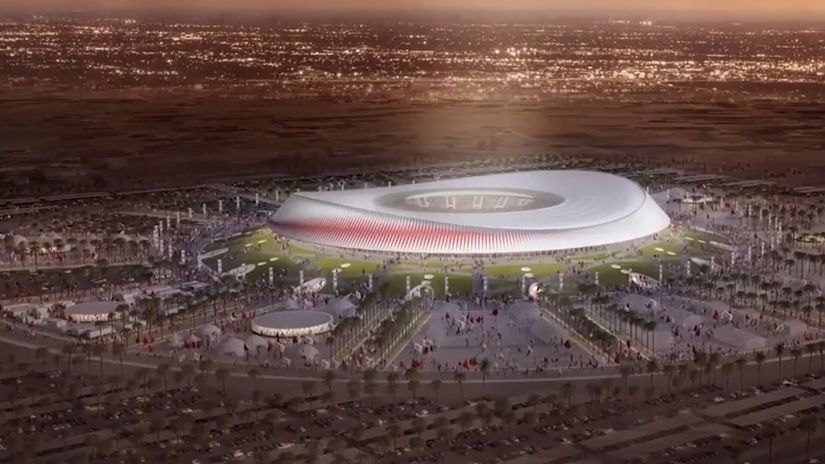The World Cups have always been the true initiators of unprecedented infrastructure solutions. Starting with the legendary Centenario and the first planetary competition, they aroused great interest of the public, and even those who are not diligent followers of sports events. From the second half of the 1960s until 2019, the Aztec Stadium in Mexico City was crowned with the prestigious title of the largest football stadium in the world, with a capacity of about 114,700 seats, but it lost that status after renovations five years ago and a reduction in the number of seats at 87,500.##EDITORS_CHOICE##The national stadium “May 1st” in the North Korean capital of Pyongyang (114,000 seats) is currently considered the largest, but it will only be for a few years. The Moroccan government has announced that it will start building a stadium in Casablanca for 115,000 people, all with the aim of convincing FIFA to award the metropolis in North Africa the hosting of the final match of the World Cup in 2030. Let us remind you that Spain, Portugal and Morocco have already received the organization of the 2030 World Cup (with several symbolic matches due to the centenary of the competition in Uruguay, Argentina and Paraguay), and Camp Nou and Santiago Bernabeu have already been seen as the only two stadiums with a real chance of winning the final. Maybe this spoils the plans in the Pyrenees…A consortium led by architects Populous and Oualalou + Choi has been awarded the contract to design the planned 115,000-capacity Grand Stade de Casablanca stadium in Morocco, projected to be the largest football stadium in the world.https://t.co/CxlifwGcDt— Populous (@Populous) March 20, 2024 Morocco plans to spend two billion dollars on the construction of new and renovation of existing buildings, and plans to allocate 500,000,000 dollars for the Grand Stade de Casablanca stadium alone. The largest stadium in the world will be part of a giant complex with an area of 100 hectares, and the distance from the center of Casablanca will be as much as 38 kilometers. Moroccans explain this decision by the proximity of Ben Slimane airport. It is expected that after the end of the World Cup, the stadium will be shared by two great city rivals, Wydad and Raja.🚨👀 Last week, Populous announced that they would be designing Morocco’s Grand Stade de Casablanca.The project is expected to result in the largest stadium in world football, with a staggering capacity of 115,000. [@MikeKeegan_DM] #MUFC pic.twitter.com/CZ4vryjhVS— United & Everything Football (@ManUnitedBall) March 25, 2024 It is interesting that the Moroccan government hired the American company Populus, which designed the new White Hart Lane seven years ago. Companies from Italy and Great Britain will be involved in the entire project. Next to the stadium itself, not only auxiliary fields will be built, but an entire complex within sections intended for the training of young players, as well as a medical block. In the summer of 2025, Morocco will host the Cup of African Nations, which will be the first rehearsal for the World Cup, and by then it should complete the renovation of at least two stadiums where the World Cup should be played.##NAJAVA_MECA_7987235##STADIUMS WHERE THE 2030 WORLD CUP COULD BE PLAYED:Centenario (Uruguay, Montevideo) – 80,000Monumental (Argentina, Buenos Aires) – 84,567Conmebol (Paraguay, Asuncion) – 60,000José Alvalade (Portugal, Lisbon) – 50,095Da Luz (Portugal, Lisbon) – 65,000Dragao (Portugal, Porto) – 50,033Grand Casablanca (Morocco, Casablanca) – 115,000Prince Moulay Abdelah (Morocco, Rabat) – 65,000IBN Batouta (Morocco, Tangier) – 80,000Grand Marrakesh (Morocco, Marrakesh) – 46,000Azadir (Morocco, Tangier) – 46,000Fez (Morocco, Fez) – 45,000Gran Canaria (Spain, Las Palmas) – 40,000Condominium (Spain, Murcia) – 42,000RCDE (Spain, Barcelona) – 40,000Romareda (Spain, Zaragoza) – 42,500Molignon (Spain, Gijon) – 40,000Riazor (Spain, La Coruña) – 45,000Balaidos (Spain, Vigo) – 40,000Rosaleda (Spain, Malaga) – 45,000Anoeta (Spain, San Sebastian) – 40,000San Mames (Spain, Bilbao) – 53,331Cartuja (Spain, Seville) – 60,000Metropolitano (Spain, Madrid) – 70,000Neuva Mestalla (Spain, Valencia) – 70,000Camp Nou (Spain, Barcelona) – 105,000Santiago Bernabeu (Spain, Madrid) – 85,000

